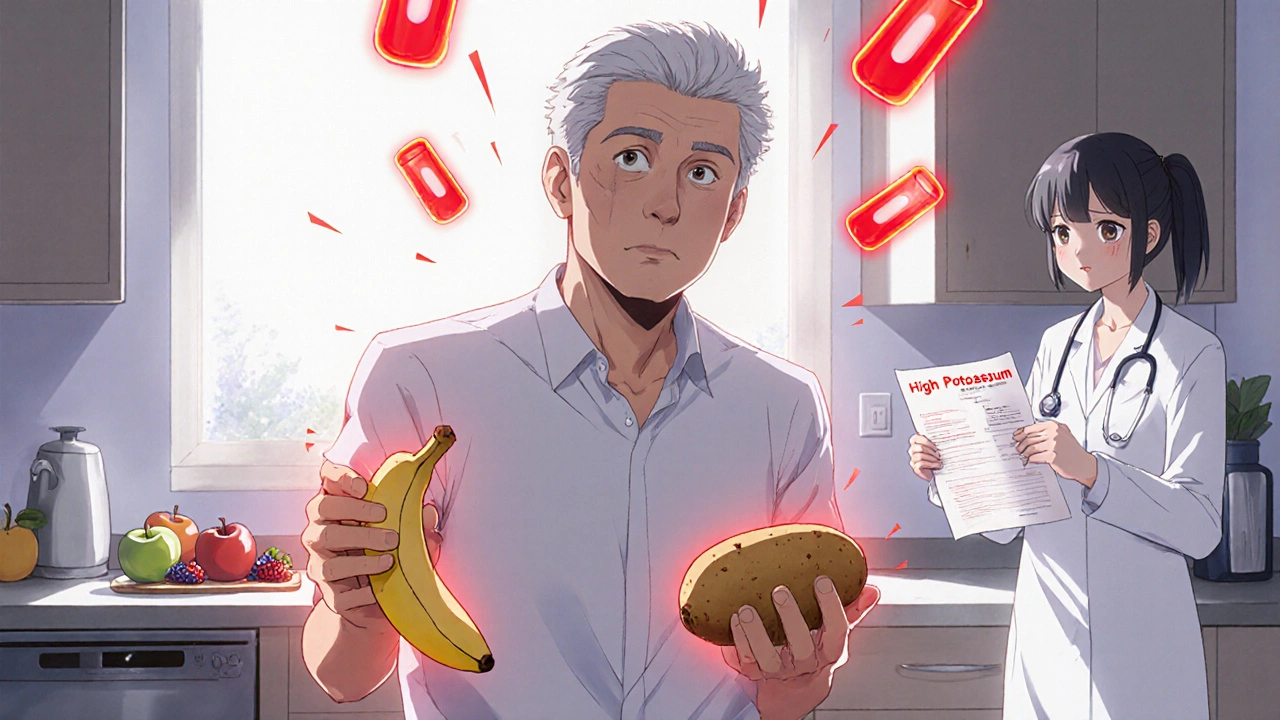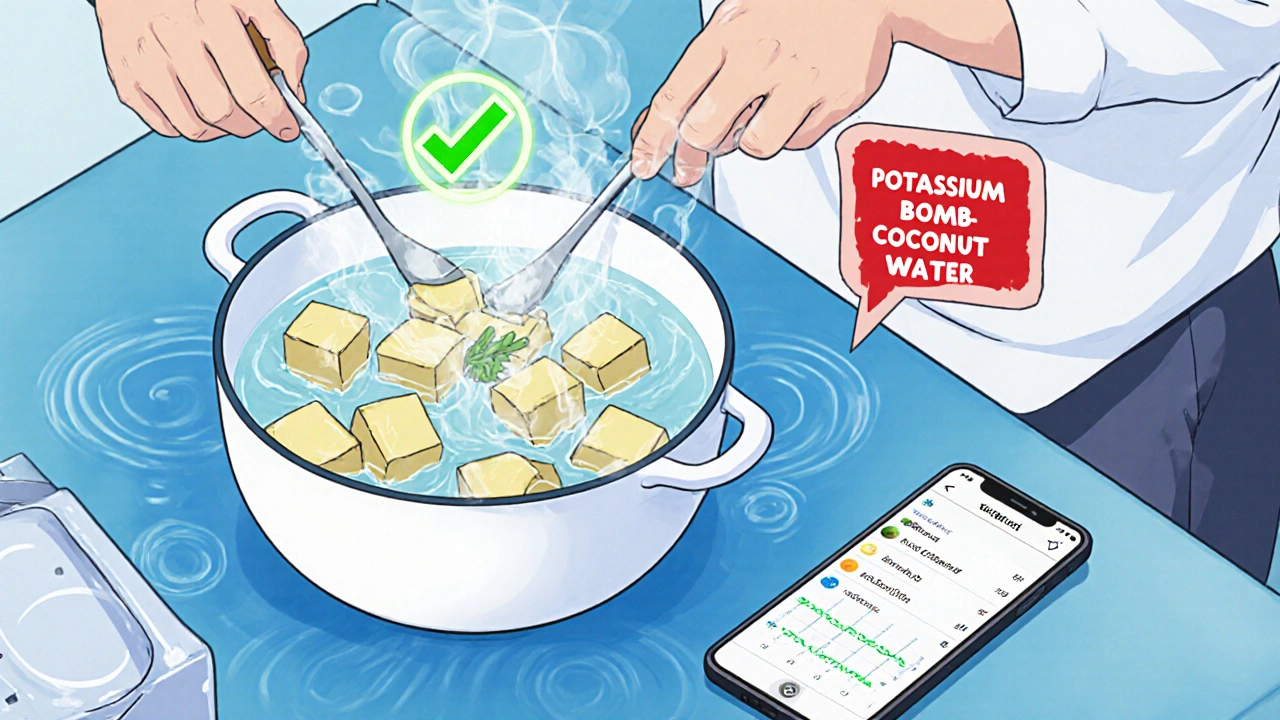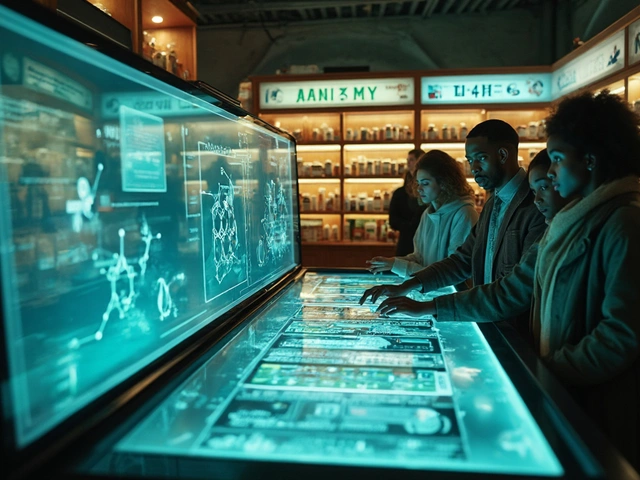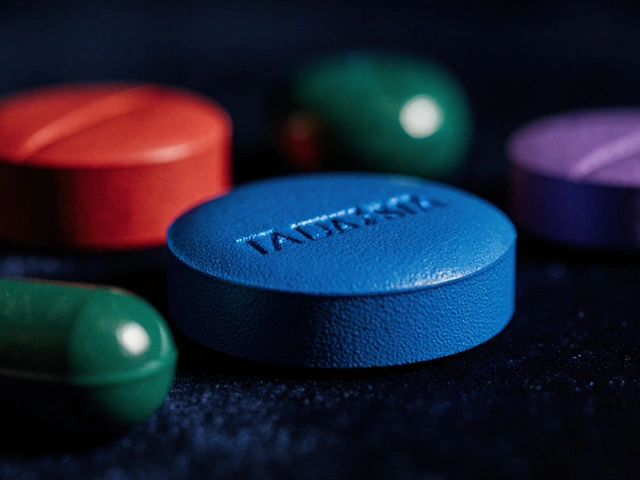ACE Inhibitors and High-Potassium Foods: How to Prevent Hyperkalemia

Potassium Intake Calculator for ACE Inhibitor Patients
Your Daily Intake
Enter your meals to calculate potassium content based on standard portions
Your Current Status
Recommended Limit: 2,000 mg for those with eGFR < 45
Normal Range: 3.5-5.0 mmol/L
High Risk: >5.0 mmol/L
Total Potassium Today
0 mg
Your daily potassium intake is within safe limits
Recommended Adjustments
Your Food Log
When you're taking an ACE inhibitor for high blood pressure, heart failure, or kidney disease, you're getting powerful protection for your heart and kidneys. But there’s a quiet danger hiding in plain sight: your food. Many of the foods you think are healthy-bananas, potatoes, spinach, avocados-can push your potassium levels too high and trigger a life-threatening condition called hyperkalemia. This isn’t a rare side effect. About 1 in 5 people on ACE inhibitors develop elevated potassium levels, especially if they have kidney problems or diabetes. The good news? You can prevent it. You don’t have to give up healthy eating. You just need to know which foods to watch and how to eat them safely.
Why ACE Inhibitors Raise Potassium Levels
ACE inhibitors work by blocking a chemical in your body that normally tightens blood vessels and tells your kidneys to hold onto salt and water. By slowing this process, they lower blood pressure and reduce strain on your heart. But there’s a side effect you might not know about: they also reduce a hormone called aldosterone. Aldosterone is what tells your kidneys to flush out extra potassium. When it drops, potassium builds up in your blood.
This isn’t just theory. Clinical studies show that within 24 hours of starting an ACE inhibitor, your body’s ability to remove potassium drops by 25% to 35%. For someone with healthy kidneys, that’s usually fine. But if your kidneys are already struggling-like in chronic kidney disease (CKD)-your body can’t keep up. Your potassium level can creep up without you feeling a thing until it’s dangerously high.
People over 75, those with diabetes, heart failure, or an eGFR below 60 are at the highest risk. In fact, diabetic patients on ACE inhibitors are nearly 50% more likely to develop hyperkalemia than those without diabetes. And if you’re also taking a potassium-sparing diuretic, trimethoprim, or a mineralocorticoid antagonist, your risk jumps even higher.
What Is Hyperkalemia-and Why It’s Dangerous
Hyperkalemia means your blood potassium level is above 5.0 mmol/L. Normal is between 3.5 and 5.0. At 5.5, you might feel nothing. At 6.0 or higher, your heart can start to beat irregularly. At 7.0 or more, your heart can stop. That’s why this isn’t something you can ignore.
Most people don’t feel symptoms until it’s advanced. You might feel weak, tired, or notice your heart skipping beats. But by then, it’s often too late to wait. That’s why regular blood tests are non-negotiable. Guidelines from the American Heart Association say you need a blood test 7 to 14 days after starting an ACE inhibitor, again after any dose change, and every 4 months after that. If your creatinine rises more than 30% or your potassium goes above 5.5, your doctor may need to adjust your meds.
High-Potassium Foods to Limit or Avoid
Here’s the hard truth: many of the foods labeled as "superfoods" are packed with potassium. If your kidneys aren’t working well, they can’t handle the load.
- One medium banana = 422 mg potassium
- One baked potato = 926 mg
- One cup cooked spinach = 839 mg
- One avocado = 708 mg
- One cup orange juice = 496 mg
- One cup cooked tomatoes = 450 mg
- One cup sweet potato = 542 mg
- 16 oz coconut water = 1,150 mg
That’s not a mistake. Coconut water is marketed as a "natural sports drink," but for someone on an ACE inhibitor with kidney disease, it’s a potassium bomb. One Reddit user reported a dangerous spike after drinking just 16 ounces daily. Same with protein powders-many add potassium chloride as a filler. Check the label.
The National Kidney Foundation recommends limiting potassium to under 2,000 mg per day if your eGFR is below 45. That’s not easy. One large baked potato alone hits nearly half your daily limit. You don’t need to eliminate these foods entirely-but you do need to be smart about portion sizes and frequency.

How to Eat Smarter: Practical Tips
You don’t have to give up vegetables. You just need to change how you prepare them.
Leach your veggies. For potatoes, sweet potatoes, carrots, and beets, peel them, cut them into small pieces, and soak them in warm water for at least 2 hours before cooking. Then rinse and boil them in a large pot of fresh water. This can cut potassium by 50% or more. Don’t reuse the soaking water.
Choose lower-potassium fruits. Apples, berries, grapes, pineapple, and watermelon are safer options. One cup of apples has only 195 mg potassium. Swap oranges for apples. Swap bananas for applesauce.
Watch the salt substitutes. Many salt substitutes are made of potassium chloride. If you’re using "Lite Salt" or "NoSalt," you’re adding potassium without realizing it. Use regular salt in moderation instead.
Read labels. Potassium is often hidden in processed foods-canned soups, frozen meals, and even some bottled waters. Look for "potassium chloride," "potassium citrate," or "potassium phosphate" on the ingredient list.
Use an app. Apps like "Renal Diet Helper" or "MyFitnessPal" (with custom potassium tracking) let you log meals and see your daily potassium total. Many patients who use these tools stay within their limits 40% more often than those who don’t.
When Medication Changes Are Needed
If your potassium stays high despite diet changes, your doctor may consider switching you to an ARB (angiotensin receptor blocker), which has a similar effect but slightly lower risk. Or they may add a potassium binder like patiromer (Veltassa) or sodium zirconium cyclosilicate (Lokelma). These medications bind potassium in your gut and flush it out in your stool. Clinical trials show they reduce the need to stop ACE inhibitors by over 40%.
But here’s the catch: these binders are expensive and require strict timing. You have to take them at least 3 hours apart from other medications, or they’ll bind those too. Don’t try to self-manage this. Work with your pharmacist and doctor.
Some doctors now avoid combining ACE inhibitors with mineralocorticoid antagonists like spironolactone, especially in advanced kidney disease. The risk of severe hyperkalemia (potassium over 6.0) jumps 58% with that combo. That’s not worth the trade-off unless you’re under close supervision.

Monitoring and Follow-Up Are Non-Negotiable
Don’t wait until you feel bad. Schedule your blood tests. Keep a log of your potassium levels. Bring it to every appointment. If your doctor doesn’t check your potassium at least every 4 months, ask why.
And if you’re seeing a dietitian? That’s a good sign. The Kidney Disease: Improving Global Outcomes (KDIGO) guidelines say everyone with CKD on an ACE inhibitor should get personalized nutrition counseling. A 2021 study showed that patients who met with a renal dietitian reduced their hyperkalemia risk by 34% compared to those who just got a handout.
One patient in Pittsburgh told me he started tracking his meals after his potassium hit 5.8. He used a laminated food chart from his clinic. Within three months, his level dropped to 4.7. He still eats potatoes-but only once a week, and only after soaking and boiling them. He swapped his morning orange for a pear. He stopped drinking coconut water cold turkey. Small changes. Big results.
What You Can Do Today
- Check your last potassium level. If it’s above 5.0, talk to your doctor about your diet.
- Make a list of the high-potassium foods you eat weekly. Cross out two.
- Soak your potatoes or sweet potatoes before cooking.
- Ask your pharmacist if any of your other meds (even OTC ones) contain potassium.
- Download a potassium tracker app and log your meals for 3 days.
- Request a referral to a renal dietitian if you haven’t had one.
ACE inhibitors save lives. But they don’t work if you have to stop them because your potassium got too high. The key isn’t fear-it’s awareness. You can eat well, stay healthy, and protect your heart-without risking your life.
Can I still eat bananas if I take ACE inhibitors?
If your kidney function is normal and your potassium levels are stable, one banana a few times a week is usually fine. But if you have kidney disease, diabetes, or your potassium has ever been above 5.0, you should avoid bananas or limit them to very small portions occasionally. Always check your blood levels first.
Do all ACE inhibitors raise potassium the same way?
Yes. All ACE inhibitors-lisinopril, enalapril, ramipril, benazepril, etc.-work by blocking the same enzyme and lowering aldosterone. So they all carry the same risk of raising potassium. The difference is in dosage and how your body responds, not the mechanism.
Is it safe to take potassium supplements with ACE inhibitors?
No. Never take potassium supplements unless your doctor specifically prescribes them-and even then, only under close monitoring. Most people get enough potassium from food. Taking extra, even a 99 mg tablet, can push you into danger if you’re on an ACE inhibitor.
How long does it take for potassium to rise after starting an ACE inhibitor?
Potassium levels can start rising within a few days, but the biggest changes usually happen in the first 1 to 2 weeks. That’s why doctors recommend your first blood test 7 to 14 days after starting the medication.
Can I drink coffee while taking ACE inhibitors?
Yes. A regular cup of black coffee has only about 116 mg of potassium. Even three cups a day won’t push you over the limit. But avoid adding milk or creamer if you’re on a strict low-potassium diet-those add extra potassium. Stick to black coffee.
What should I do if I miss a blood test?
Call your doctor’s office right away. Missing a test is risky. If your potassium has been rising, you might need to adjust your diet or medication before it becomes dangerous. Don’t wait until you feel weak or your heart races. Prevention is easier than emergency treatment.






Marshall Washick
November 3, 2025 AT 08:20I’ve been on lisinopril for 3 years after my heart attack, and I didn’t realize how much potassium was in my daily smoothie until my doctor flagged it. I used to blend spinach, banana, and avocado-thought I was being healthy. Now I swap spinach for iceberg lettuce, use half a banana max, and skip the avocado. My last potassium was 4.2. Small changes, big difference.
Also, soaking potatoes changed everything. I cut them thin, soak overnight, boil in fresh water. Tastes just as good. My grandma taught me this for her kidney issues back in the 90s. Still works.
Abha Nakra
November 5, 2025 AT 04:20Just wanted to add-coconut water isn’t the only sneaky one. Protein powders with potassium chloride are everywhere. I used to take one after workouts. My potassium jumped from 4.8 to 5.9 in 3 weeks. Switched to a brand that uses magnesium instead. No more panic blood draws.
And yes, apps help. I use MyFitnessPal and set a 2000mg daily limit. It’s annoying at first, but after a week, you just know which foods are safe. No need to memorize numbers.
Tatiana Mathis
November 6, 2025 AT 04:51Thank you for writing this with such clarity. I’m a renal dietitian in Ohio, and I see this exact scenario every week. Patients are terrified to eat anything green or orange, so they end up malnourished or eating processed junk because they think ‘low potassium’ means ‘no vegetables.’
The key is not elimination-it’s preparation and portion control. Leaching works. Boiling vegetables in large volumes of water reduces potassium significantly. And yes, apples are your friend. So are white rice, pasta, and egg whites. You can still eat a balanced, delicious diet. It’s not punishment-it’s precision.
Also, if your doctor isn’t checking potassium every 4 months, find a new one. This isn’t optional. It’s as essential as checking your blood pressure.
And if you’re on spironolactone with an ACE inhibitor? That’s a red flag. I’ve seen patients code blue from that combo. Please, talk to your pharmacist. They know the interactions better than most doctors.
Nishigandha Kanurkar
November 7, 2025 AT 11:26Wait-so you’re telling me the pharmaceutical companies KNOW this? They know ACE inhibitors cause potassium to spike, and they still push them like candy? And then they sell you $500/month binders to fix the problem they created? And your doctor won’t even test you unless you ask? And the FDA just sits there? This isn’t medicine-it’s a money machine.
They don’t want you to know about leaching. They want you to buy Veltassa. They don’t want you to know potatoes can be made safe-they want you to avoid them forever. This is control. This is manipulation. And they’re laughing all the way to the bank while you’re scared to eat a banana.
Check your meds for ‘potassium chloride’-it’s in 70% of OTC supplements. They’re poisoning you slowly. And no one’s talking about it.
Wake up.
!!
Melissa Delong
November 8, 2025 AT 09:40I’ve been on ACE inhibitors for 8 years. My potassium has never been above 5.0. I eat bananas, spinach, and avocados every day. I’m 72, diabetic, and my kidneys are fine. So why are you scaring people? Maybe your doctor is bad. Maybe you’re not following up. Don’t blame the medicine. Blame the lack of monitoring.
Also, I drink coconut water. No problem. Maybe your body handles it differently. Stop generalizing.
Neal Burton
November 9, 2025 AT 06:20Let’s be honest: most people who panic about potassium levels are the same ones who Google every symptom and then show up at the ER with a printout from WebMD. This isn’t a crisis. It’s a manageable lab value. If your potassium is 5.1, you’re not dying. You’re slightly out of range. Chill.
Also, leaching potatoes? That’s a 1970s home remedy. Modern nephrology doesn’t rely on soaking. It relies on medication adjustment and dietary counseling-not peasant techniques.
And apps? If you’re logging every banana like it’s a crime, you’ve got orthorexia, not hyperkalemia.
Stop fearmongering. Your doctor is not your enemy. Your anxiety is.
Tamara Kayali Browne
November 9, 2025 AT 13:32Let’s analyze this post statistically. 1 in 5 people on ACE inhibitors develop elevated potassium? That’s a 20% incidence rate. But the post cites no primary source. No DOI. No journal name. Is this from a meta-analysis? A retrospective cohort? Or just anecdotal data from Reddit? The American Heart Association recommendation is cited, but no guideline number. KDIGO? No version. Veltassa trials? No phase or sample size.
This is not evidence-based medicine. This is fear-driven content marketing disguised as patient education. You’re creating unnecessary anxiety in a population already burdened by chronic illness. The real danger isn’t potassium-it’s misinformation dressed as authority.
Also, ‘download an app’? Which one? Name it. Provide a link. Otherwise, this is just fluff.
Lori Johnson
November 10, 2025 AT 18:46My mom’s potassium hit 6.2 last year. She didn’t feel a thing. One minute she was gardening, the next she was in the ER with a heart rhythm that looked like a zigzag on the monitor. They gave her calcium gluconate, insulin, and dialysis. She’s fine now-but she won’t touch a banana again. Or coconut water. Or salt substitute.
She used to think this was all hype. Now she carries a laminated card in her wallet with safe foods. She even shows it to waiters. It’s not embarrassing-it’s life-saving.
Don’t wait until your heart skips. Check your numbers. Soak your potatoes. Ask your pharmacist. You’ve got this.